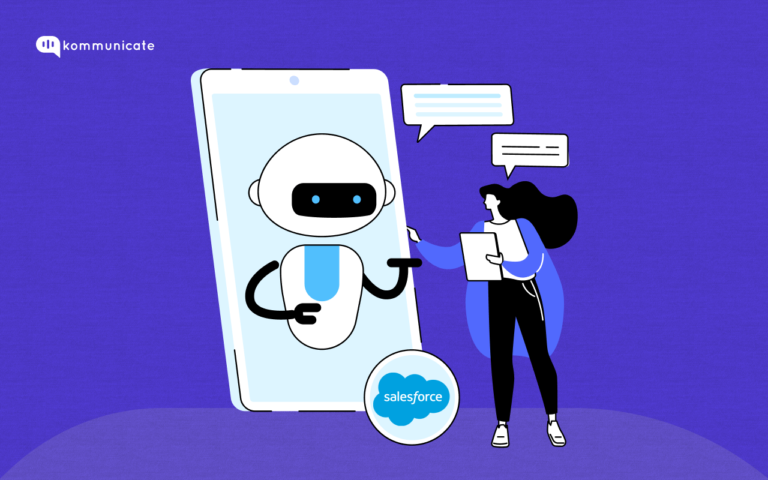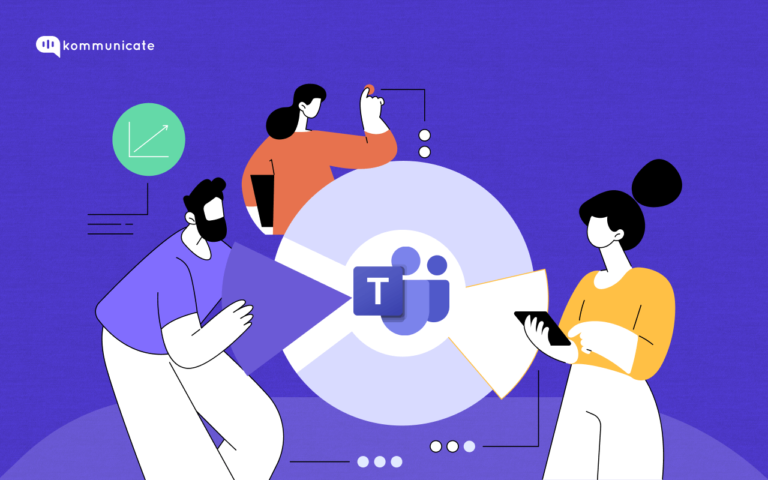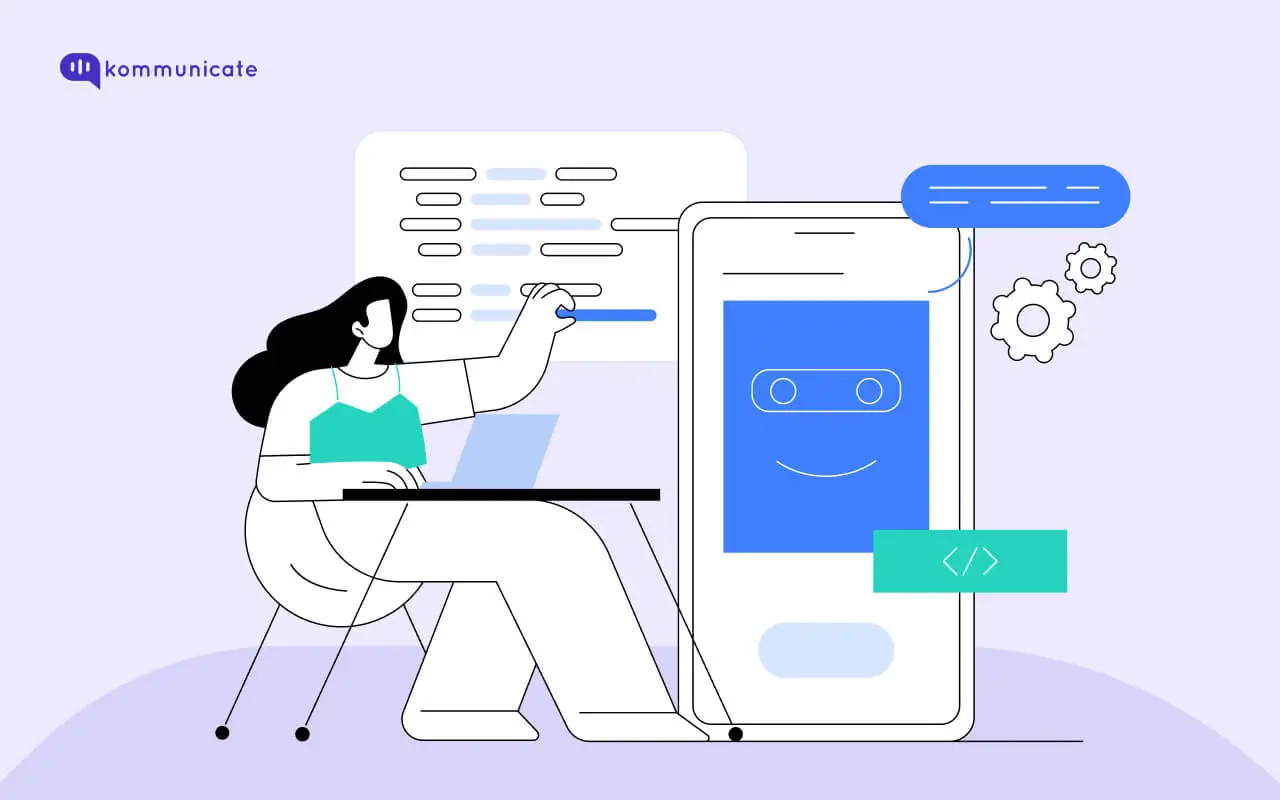Updated on February 12, 2023
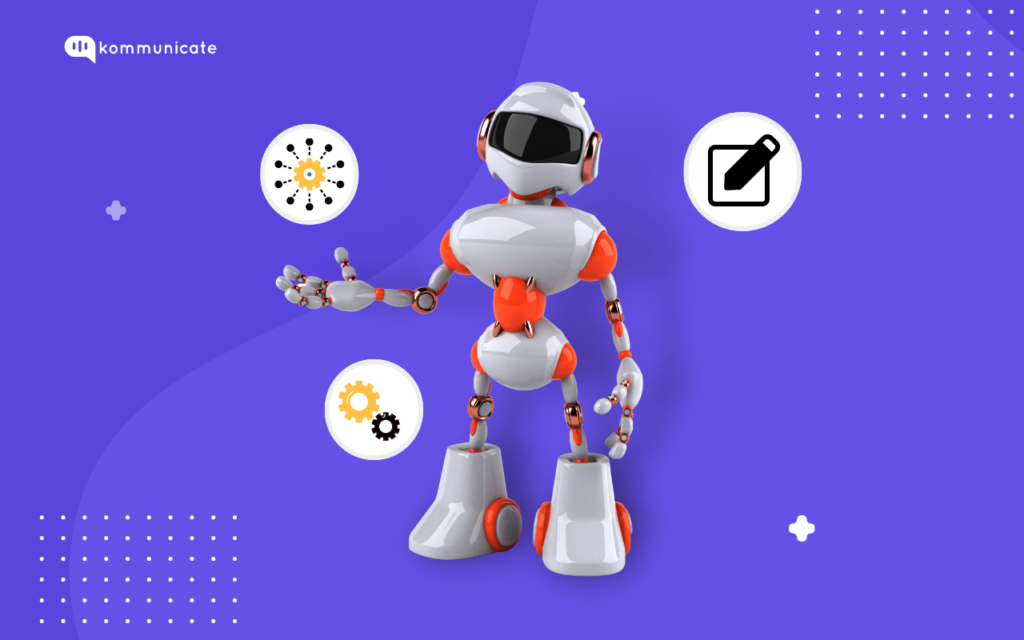
Customers prefer to solve minor problems in all aspects of their life, including shopping for products and services. When it comes to purchasing, self-service tools help customers troubleshoot minor problems and complete a purchase. This bot guide will help you understand the Ikea effect and how chatbots can empower customers.
In a study conducted by Harvard Business School researchers found something really interesting. People were more likely to buy products that they had a role in building than buying something that was pre-built by another person or company.
Our bot guide will cover how companies use self-service to boost marketing and sales and add to the bottom line.
Suggested read: Step-by-step guide to create your Chatbot without Code
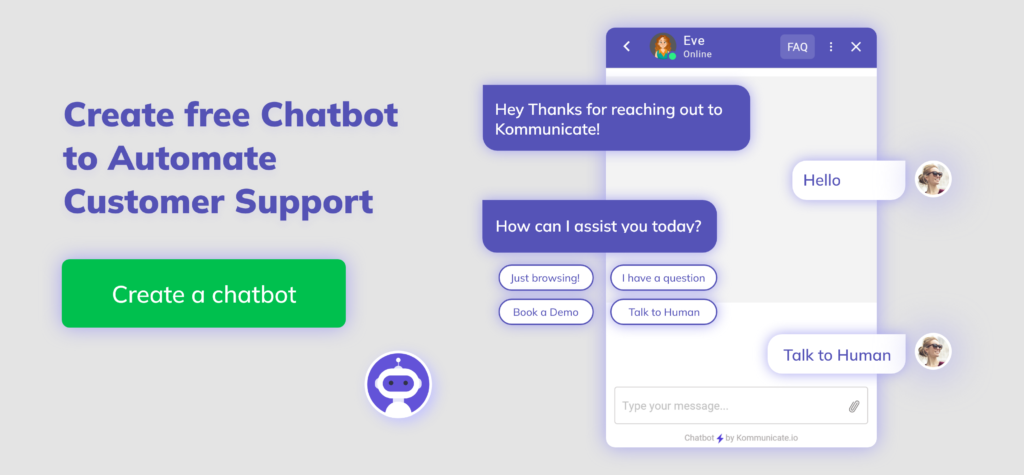
1. How can bots sound more human?
These days, it can be complicated to distinguish a chatbot from a real person. Chatbots have become more intelligent. There are several strategies that they use to sound more human.
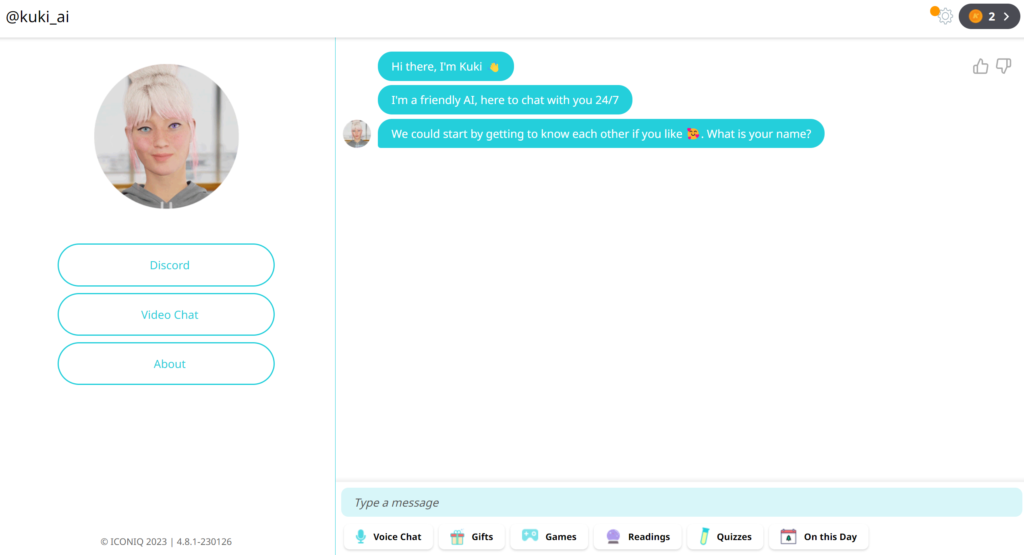
- Repeating the query. If the person doesn’t hear the phrase or sentence, they must ask to repeat it. Chatbots tend to do the same. Moreover, they fill the conversations with such words as ‘Well’ or ‘Um’ if there are pauses. As a result, the customer is fully involved in the conversation.
- Becoming supportive. The main task of chatbots is to ask and answer questions. However, nowadays, chatbots ask about the client’s feelings and emotions. It leads to increasing customers’ trust and loyalty.
- Adopting speech styles. To make chatbots more human, developers tend to add a bunch of human characteristics. As a result, chatbots can be programmed to display human thought patterns. So, people believe that they communicate with a real person.
Modern technologies bring a lot of innovations to the IT market. Chatbots aren’t an exception. For instance, Mitsuku (one of the most popular chatbots) starts talking about work-related issues every time a user says such words as ‘boss,’ ‘job,’ and others. It even can complain about work and its boss.
Human-like AI-based chatbots tend to trick people since they can analyze their behavior and emotions. Also, such chatbots tend to make decisions depending on human behavior.
2. Reasons to Create a Chatbot for Your Business
We’ve singled out four main benefits of integrating a chatbot into your business.
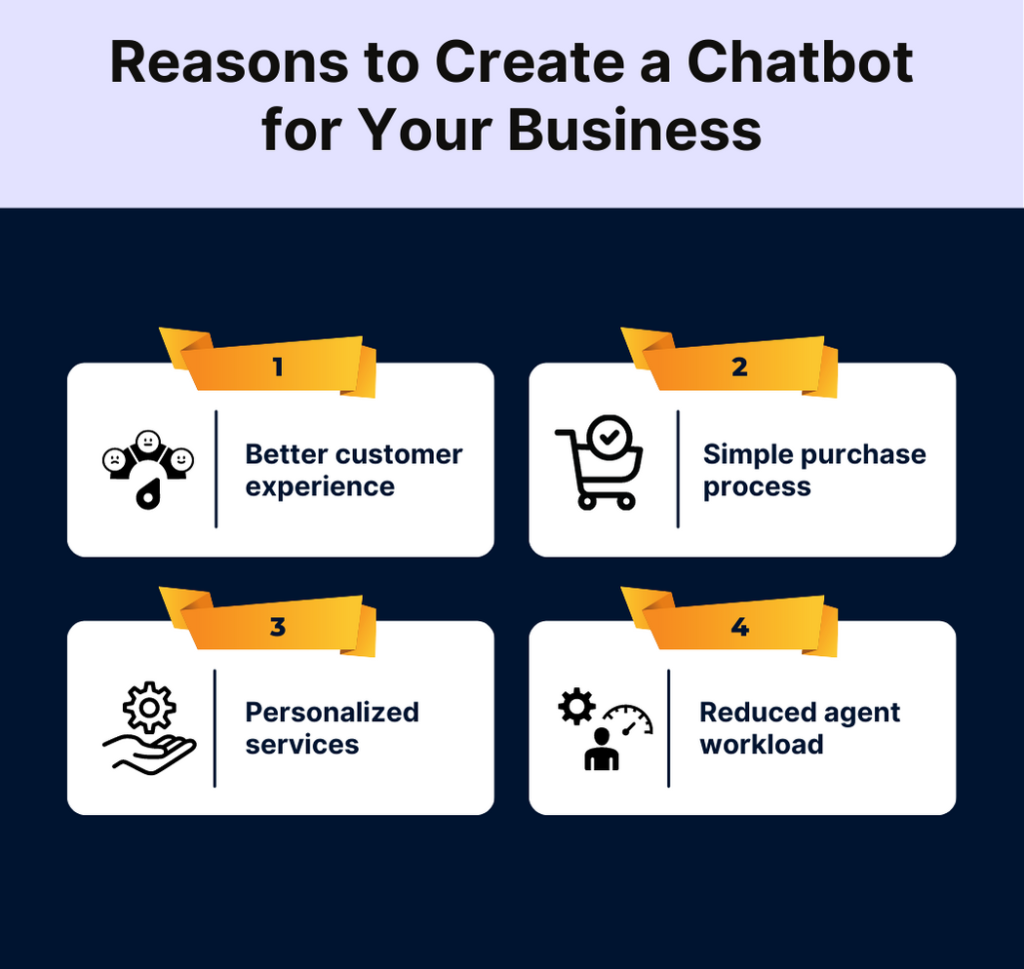
a. Better customer experience
Chatbots are available 24/7, providing customers with quick answers around the clock. For example, a fast-food company from the USA called Taco Bell created a chatbot to automate sales. The company integrated a bot into a Slack messenger since it’s quite popular among office workers. The chatbot helps make orders in the restaurant and sets the delivery details.
b. Simple purchase process
Chatbots can answer customers’ questions. But also, they offer customers to order right from a messenger.
Also, chatbots are perfect for fighting users’ hesitation. Chatbots can remember the previous questions and analyze this data. As a result, they offer more accurate things, and users want to buy more.
c. Personalized services
Chatbots offer many significant opportunities to personalize the user experience. Bots can collect and analyze customers’ choices and offer personalized recommendations to purchase products and services.
d. Reduced agent workload
Offering 24/7 customer support, chatbots can reduce the number of support agents required. While complex queries can be handled by human agents, repetitive queries can be handled adequately by chatbots.
As you can see, chatbots tend to bring a lot of advantages to the business. However, chatbot development can be time-consuming. Below we discuss why.
3. Type of Chatbots
There are two main chatbot types — rule-based and AI, depending on their complexity. Let’s discuss them more precisely.
a. Rule-based chatbots and their benefits
Compared to AI chatbots, rule-based ones tend to be more straightforward. They manage a bunch of tasks, following various scenarios.
Simply put, these chatbots have a ‘conversation map.’ There is a list of questions users tend to ask and chatbots’ responses.
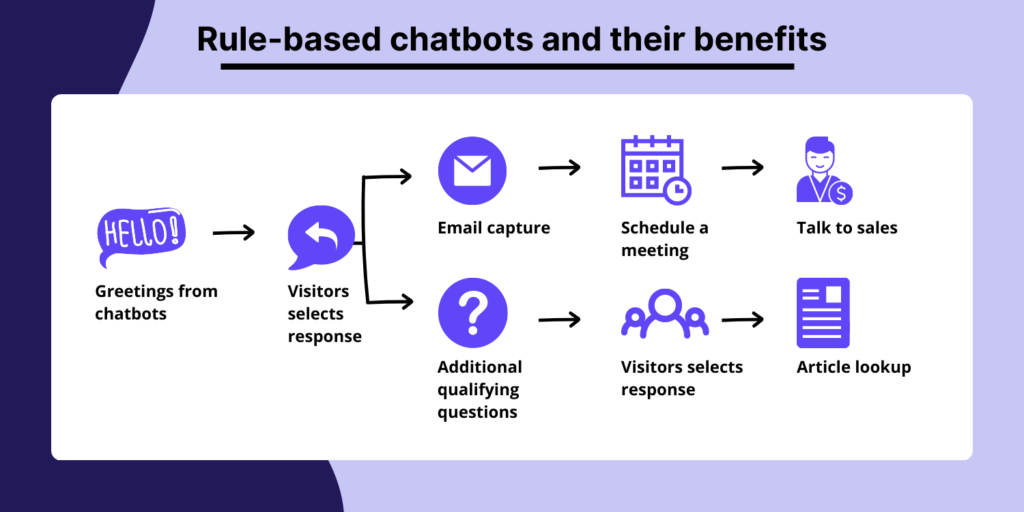
Rule-based chatbots are suitable for small businesses that follow particular goals, such as answering FAQs.
Advantages of rule-based chatbots:
- Lower development costs
- Security
- Ability to include media files.
b. AI Chatbots and their benefits
These bots use machine learning technology to understand the user’s questions and intentions. Then, they create a response.
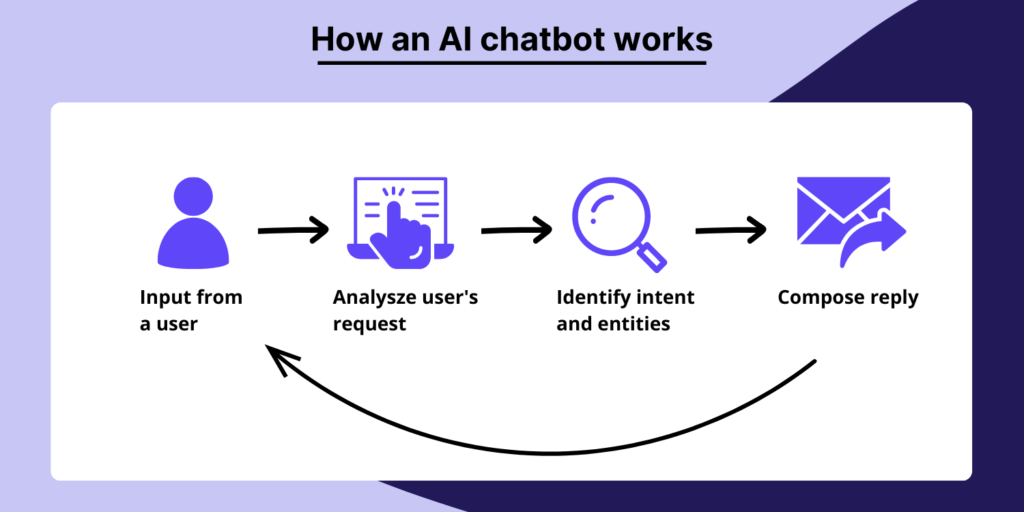
AI bots tend to learn from users, offering better feedback. However, its development is quite time-consuming and expensive.
Advantages of AI chatbots:
- Ability to analyze the collected information and customers’ behavior;
- Possibility to communicate in several languages;
- Decision making.
What type of chatbot does your business require?
Both rule-based and AI chatbots have a lot of advantages, and it’s impossible to say which type is better. You must analyze your business goals and requirements to pick the right type.
If you need a chatbot to answer FAQ, it’s better to consider rule-based solutions. Such bots are perfect for fulfilling basic tasks. AI chatbots are great for more complicated functions since they can make decisions. As a result, they require less support from human workers.
4. How to Create a Chatbot for Your Business
There are five main steps that you need to follow to make a chatbot for your company, following your goals and requirements.
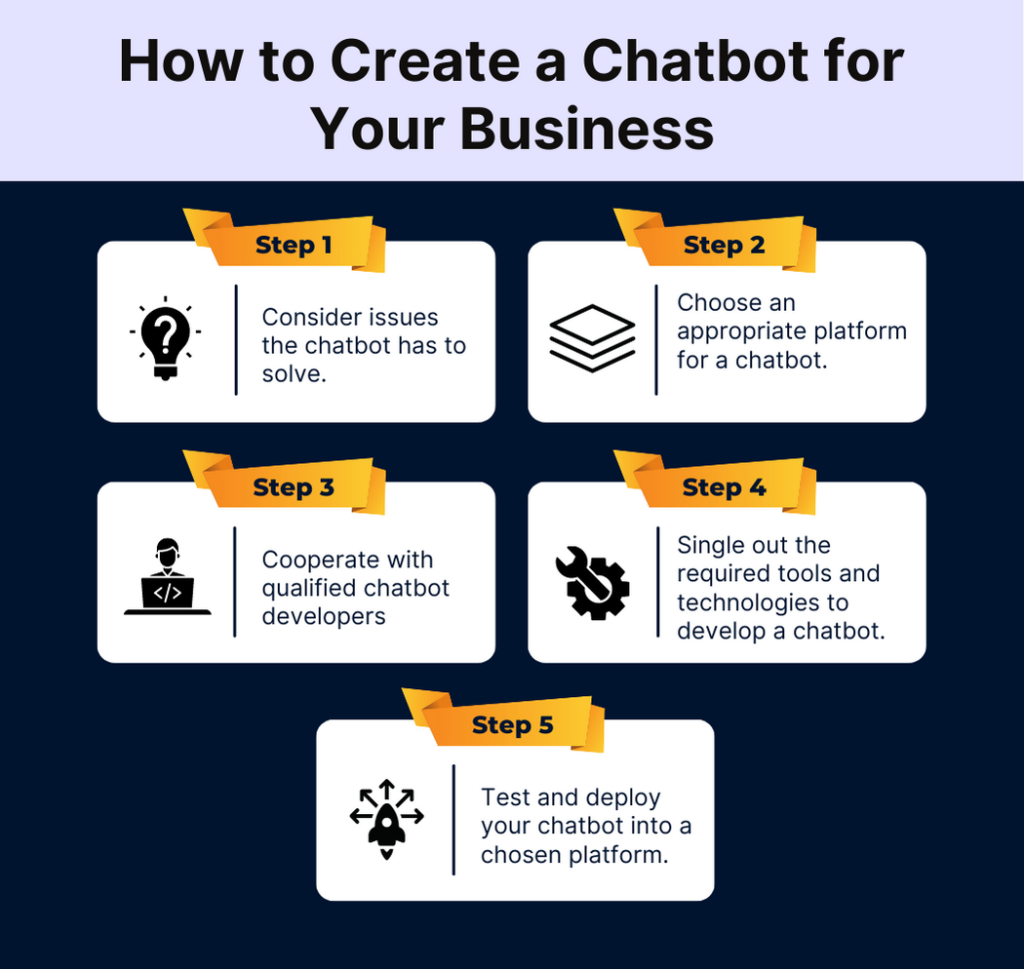
Step #1. Figure out customers’ needs
The main reason to create a chatbot is to improve user experience. So, you need to analyze the customers’ expectations carefully.
After that, it’s easy to create a list of required features. Additionally, to reach success, you need to consider an attractive and straightforward design.
Step #2. Pick a platform for a chatbot
There are a bunch of platforms to integrate a chatbot, like messengers, websites, and more. You need to consider users’ expectations.
You can integrate a chatbot into a company’s website or application. Many enterprises create chatbots for Facebook Messenger, Skype, and others.
Step #3. Recruit experienced developers for chatbot development
You need to work with qualified developers to create a custom chatbot. There are three main ways to hire a development team —
a. Coordinate with freelancers
Freelance developers tend to have the lowest hourly rates, but controlling the development process is difficult. Freelancers aren’t the best option since they tend to miss deadlines. If you aren’t a tech guru, it will be difficult to control the quality of the final product. As a result, you can face a bunch of bugs in the future.
b. Hire in-house teams
As for in-house development, it’s quite easy to manage the team. However, there are a lot of additional expenses, like rent, taxes, and so on. These days, outsourcing development is becoming popular. Such companies usually have affordable hourly rates along with excellent quality.
c. Work with outsourcing companies.
As for outsourcing development, this option offers great development opportunities. Many countries in Eastern Europe have many qualified developers that get affordable rates. As a result, you can create a tech-savvy product at a reasonable price.
Each option has pros and cons.
Of course, it’s up to you to decide what hiring option to choose. You need to consider your requirements and expectations from the cooperation. If you need instant feedback from your development team, it’s better to pick in-house builders.
Each hiring option can change the cost to build a chatbot significantly. It means that you need to consider each option precisely and choose the one that fits your business.
To hire experienced chatbot developers, you can use the following services.
Step #4. Shortlist tools and technologies to develop a chatbot
There are two main ways to develop a chatbot — tools, and frameworks.
By choosing the first variant, you can make some limited chatbot features. Frameworks allow building complicated solutions to meet all your requirements.
To give you a hint, we’ve listed popular tools for chatbot development. We’ll discuss these technologies more precisely in the next part of our guide.
- Kompose
- Chatfuel
- Botsify
- Flow XO
As for frameworks, there are also some options.
- Facebook Wit.AI
- IBM Watson
- Microsoft Bot Framework
Step #5. Test and Deploy
To succeed, you must test the chatbot and deploy it carefully.
Testing allows for eliminating any bugs. It leads to a better customer experience. You need to monitor the chatbot’s conversations and decisions during this stage. Also, you can improve your solution by subjecting it to internal and external user tests.
6. How to Create a Chatbot: Platforms and Frameworks
These days, there are many ways to create a chatbot. If you want a straightforward solution, you can use a platform for chatbot development. However, in the case of custom solutions, it’s better to use frameworks. The second option requires cooperation with experienced developers.
Let’s single out the details of every option.
A. Chatbot Builder Tools
There are many platforms for chatbot development. It’s better to pick a tool according to your business needs and requirements.
Such platforms tend to have limited opportunities so that the chatbot won’t perform complicated tasks.
Below we’ve listed the most widespread tools.
- Kompose. Kompose is a GUI bot builder based on NLP for Human-Computer interaction. You don’t need any coding skills to build your Bot. It has a simple, intuitive, and easy-to-use interface.
- Chatfuel. This platform helps make Facebook Messenger chatbots. Chatfuel allows integrating such features as sharing updates automatically and collecting information from the chats. This solution creates bots that interact with clients via buttons.
- Botsify. This platform allows the creation of bots for websites, Facebook pages, and messengers. Botsify focuses on developing AI-based chatbots to improve customer support.
- Flow XO. Using Flow Xo, you can create solutions for websites, mobile apps, and various social media platforms. The platform offers many pre-built templates that allow making the development process faster.
B. Chatbot Development Frameworks
If you want to create a complicated chatbot, you need to choose custom development using frameworks.
Such chatbots tend to fulfill all your business needs and requirements. However, their development is more expensive in comparison to chatbot maker tools.
Also, you need to cooperate with qualified developers unless you’re a technical guru.
Below you can find popular frameworks for custom chatbot development.
- Facebook Wit.AI. Using this framework, you can develop text or voice-based chatbots. Facebook Wit.AI uses machine learning technology to learn from users. You can use this framework with such programming languages as Ruby, Node.js, and Python.
- IBM Watson. IBM Watson has a pre-integrated architecture that helps create custom chatbots. The framework works with a bunch of platforms like websites and messengers.
- Microsoft Bot Framework. Microsoft has created a framework to develop smart chatbots. They can listen, talk, and communicate with customers. The bots can be integrated into Slack, Facebook Messenger, Skype, and other platforms.
You need to consider your business goals and requirements when choosing tools for developing a chatbot. After that, you can decide what type of chatbot is required — rule-based or AI chatbot.
It’s better to consult with experienced developers before picking development technologies.
Having a small business, you can satisfy your needs with a rule-based chatbot that can only answer FAQ questions.
However, in the case of a big company with various tasks, it’s better to invest in custom chatbot development.
Suggested read: Dialogflow vs Lex vs Watson vs Wit vs Azure Bot?
7. Chatbot use cases
Chatbots have several use cases that extend beyond the realm of customer support. Here we will cover a few of those use cases.
1. Marketing
Marketing is a broad area that can benefit from the diversification of customer-engagement strategies. This is mostly why well-established companies recruit conversational designers to proactively engage with their customers. Chatbots can be trained to act as amazing lead-generation tools as well. For example: Sephora’s AI assistant helps its customers select the product that is right for them. It also educates customers on the various products available.
2. Customer support
One of the more conventional ways to use chatbots is to meet customers on the channel of their choice and solve issues. Chatbots can offer unwavering support to brand customers by handling FAQs. They can also route complex queries to agents.
Such customer support automation ensures that your brand can have an omnichannel presence with consistent brand messaging.
3. Sales
Chatbots are excellent at guiding consumers through the sales funnel from awareness to action. They can hand-hold customers, guiding them through the products they like and prompting a buying decision.
8. The Latest Trends in Chatbot Development
While chatbots are not new in any sense, their development has great potential and has numerous trends in progress. Here we will cover the latest trends in chatbot development.
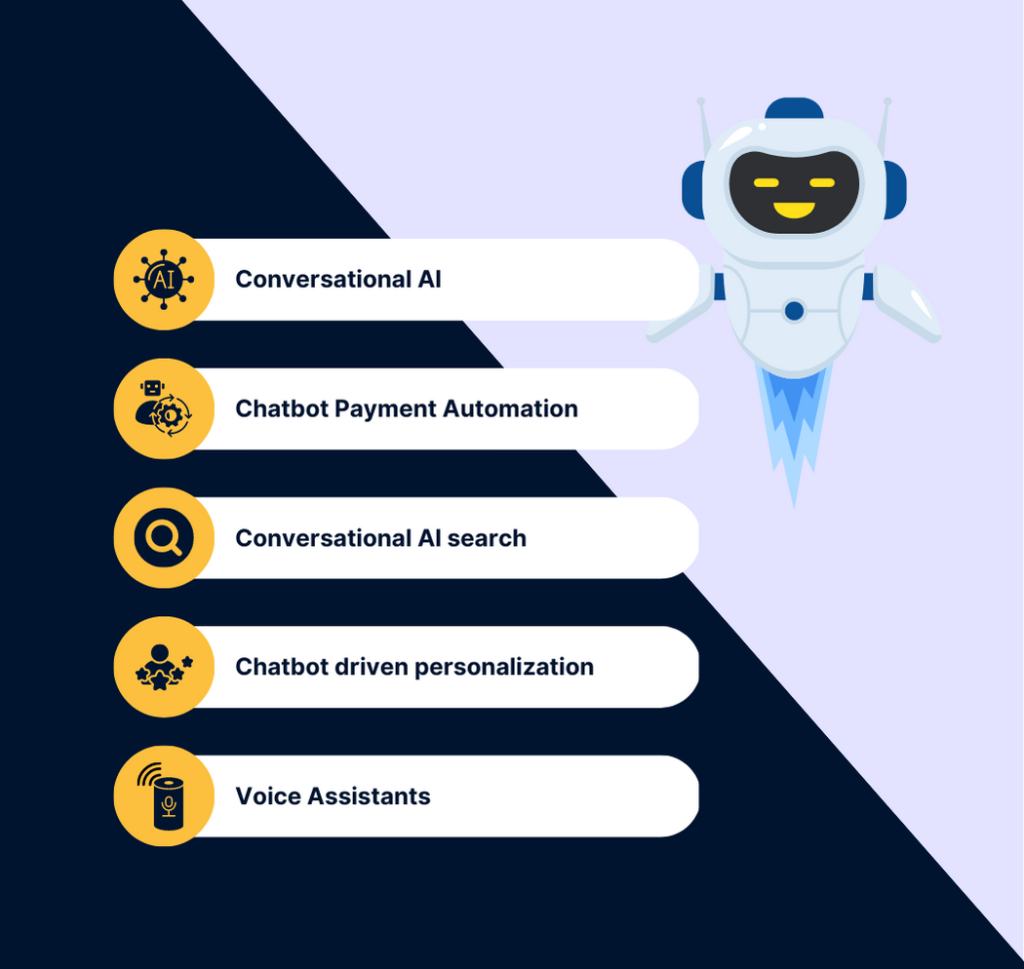
1. Conversational AI chatbots to drive messaging
Consumers are no longer passive users who rarely engage with brands. Customers want to engage actively with their brands of choice. The best way to meet this need is to meet users on messaging platforms with conversational AI. Chatbot marketing strategy is a great way to engage, acquire and even retain customers.
2. Chatbots to automate payments
The financial implications of chatbot implementation go far beyond just marketing and sales. With ecommerce and m-commerce coming to the forefront, chatbot-driven payments are quickly becoming the norm. Chatbots can drive account management and banking and this trend will continue in the near future.
3. Search powered by Conversational AI
The way forward for searches is conversational media, with chatbots leading the charge. AI chatbots can enable interactive and engaging searches, providing precise results.
4. Chatbot-driven personalization
Customers value personalization over all else while participating in the buyer journey. Research from McKinsey shows that consumers are more likely to buy from brands that personalize their experience. Chatbots can provide highly personalized product and service recommendations that keep the customer engaged for longer periods.
5. Voice assistants
Google Assistant, Alexa, and Siri-enabled devices drive many smart concepts. These can range from smart homes to smart manufacturing plants. A conversational interface is the next iteration of automation driving enterprises ahead.
Here are a few reasons why voice assistants are gaining popularity:
- Enables multitasking – Users can perform other tasks while enquiring about the weather forecast, sending a message or scheduling a meeting.
- Instant responses – Customers can expect instant responses to task requests over a conversational interface that is seamless
- Sentiment Analysis – Voice assistants can better gauge a customer’s mindset using the tone of voice. Businesses can respond to customers depending on whether the customer is frustrated, satisfied, or confused with the product.
9. AI Chatbots emulating human characteristics
A bot guide would be incomplete without mentioning the successful implementation of chatbots in the market. Here are a few such instances:
1. ManyChat
ManyChat is a chatbot on Facebook Messenger that assists the e-commerce field. This chatbot has a bunch of cool features. For instance, the service can book an appointment, sell a good, or analyze customers’ contact details. Also, ManyChat can be connected to various tools like Google Sheets, HubSpot, Spotify, and others.
2. Watson Assistant
The company launched Watson Assistant in 2016. At the core of this chatbot is Machine Learning technology. It allows for an understanding of human needs.
Watson Assistant communicates with users, understanding their needs. For example, it can fulfill the required additional information. Additionally, Watson Assistant can redirect the customer to the human worker in case of misunderstandings.
3. Mitsuku
I’ve already mentioned Mitsuku in this guide. It’s a powerful AI-based chatbot that can converse on any topic.
Moreover, this chatbot can understand the user’s mood and emotions. As a result, the dialogue is quite comfortable.
The developers claim that Mitsuku understands the user’s mood. The chatbot knows various languages, so it can answer in the customers’ language.
Interestingly, Mitsuku starts using slang words if the user does.
Wrapping Up
If there’s anything to take away from this bot guide, it is that the potential within chatbot technology is limitless. Whether it is customer engagement through proactive customer service or chatbot-driven payments in e-commerce, the applications are considerable.
With the proper implementation of conversational AI and chatbot technology, consumers and brands can connect on a personal level. Deeper relationships with customers can be encouraged, increasing the customer lifetime value for a brand. Focus on self-service and targeted customer interaction can power a new wave of seamless business for both the brand and the consumer.
Suggested Read: 14 Best AI Chatbot Development Frameworks & Platforms [With Pricing]
Author’s bio
Vitaly Kuprenko is a writer for Cleveroad. It’s a web and mobile app development company with headquarters in Ukraine. He enjoys writing about technology and digital marketing.
At Kommunicate, we are envisioning a world-beating customer support solution to empower the new era of customer support. We would love to have you on board to have a first-hand experience of Kommunicate. You can signup here and start delighting your customers right away.



